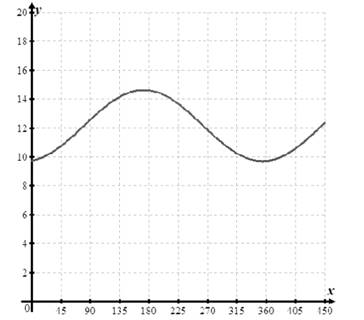
(a)
To find: The sinusoidal function.
(a)
Answer to Problem 96RE
The sinusoidal function is
Explanation of Solution
Given;
The number of hours on the Summer solstice is 14.63
The number of sunlight on the winter solstice is 9.72
Calculation:
The amplitude is calculated as,
The vertical shift is calculated as,
The days are 365.
Write the sinusoidal equation in the form.
Calculate
Write the sinusoidal equation in the form.
Solve further as,
Thus, the sinusoidal function is
(b)
To find: The number of hours of sunlight on April 1.
(b)
Answer to Problem 96RE
The number of hours of sunlight on April 1 is 12.6
Explanation of Solution
Substitute 91 for x in
Thus, the number of hours of sunlight on April 1 is 12.6
(c)
To find: The graph for the function.
(c)
Answer to Problem 96RE
The graph for the function is shown in figure 1.
Explanation of Solution
The graph is drawn as,

Figure 1
Thus, the graph for the function is shown in figure 1.
(d)
To find: The comparison of the actual hours of day light.
(d)
Answer to Problem 96RE
The hours are same as the predicted time.
Explanation of Solution
The total number of hours is 12.6 of sunlight on April 1 according to the Old Farmers Almanac. The above hours are same as the predicted time.
Thus, the hours are same as the predicted time.
Chapter 6 Solutions
Precalculus
Additional Math Textbook Solutions
College Algebra with Modeling & Visualization (5th Edition)
A Problem Solving Approach To Mathematics For Elementary School Teachers (13th Edition)
College Algebra (7th Edition)
Elementary Statistics (13th Edition)
- Let the region R be the area enclosed by the function f(x)= = 3x² and g(x) = 4x. If the region R is the base of a solid such that each cross section perpendicular to the x-axis is an isosceles right triangle with a leg in the region R, find the volume of the solid. You may use a calculator and round to the nearest thousandth. y 11 10 9 00 8 7 9 5 4 3 2 1 -1 -1 x 1 2arrow_forwardLet the region R be the area enclosed by the function f(x) = ex — 1, the horizontal line y = -4 and the vertical lines x = 0 and x = 3. Find the volume of the solid generated when the region R is revolved about the line y = -4. You may use a calculator and round to the nearest thousandth. 20 15 10 5 y I I I | I + -1.5 -1 -0.5 0.5 1 1.5 2 2.5 3 -5 I -10 -15 I + I I T I I + -20 I + -25 I I I -30 I 3.5 4 xarrow_forwardplease show all the workarrow_forward
 Calculus: Early TranscendentalsCalculusISBN:9781285741550Author:James StewartPublisher:Cengage Learning
Calculus: Early TranscendentalsCalculusISBN:9781285741550Author:James StewartPublisher:Cengage Learning Thomas' Calculus (14th Edition)CalculusISBN:9780134438986Author:Joel R. Hass, Christopher E. Heil, Maurice D. WeirPublisher:PEARSON
Thomas' Calculus (14th Edition)CalculusISBN:9780134438986Author:Joel R. Hass, Christopher E. Heil, Maurice D. WeirPublisher:PEARSON Calculus: Early Transcendentals (3rd Edition)CalculusISBN:9780134763644Author:William L. Briggs, Lyle Cochran, Bernard Gillett, Eric SchulzPublisher:PEARSON
Calculus: Early Transcendentals (3rd Edition)CalculusISBN:9780134763644Author:William L. Briggs, Lyle Cochran, Bernard Gillett, Eric SchulzPublisher:PEARSON Calculus: Early TranscendentalsCalculusISBN:9781319050740Author:Jon Rogawski, Colin Adams, Robert FranzosaPublisher:W. H. Freeman
Calculus: Early TranscendentalsCalculusISBN:9781319050740Author:Jon Rogawski, Colin Adams, Robert FranzosaPublisher:W. H. Freeman
 Calculus: Early Transcendental FunctionsCalculusISBN:9781337552516Author:Ron Larson, Bruce H. EdwardsPublisher:Cengage Learning
Calculus: Early Transcendental FunctionsCalculusISBN:9781337552516Author:Ron Larson, Bruce H. EdwardsPublisher:Cengage Learning





